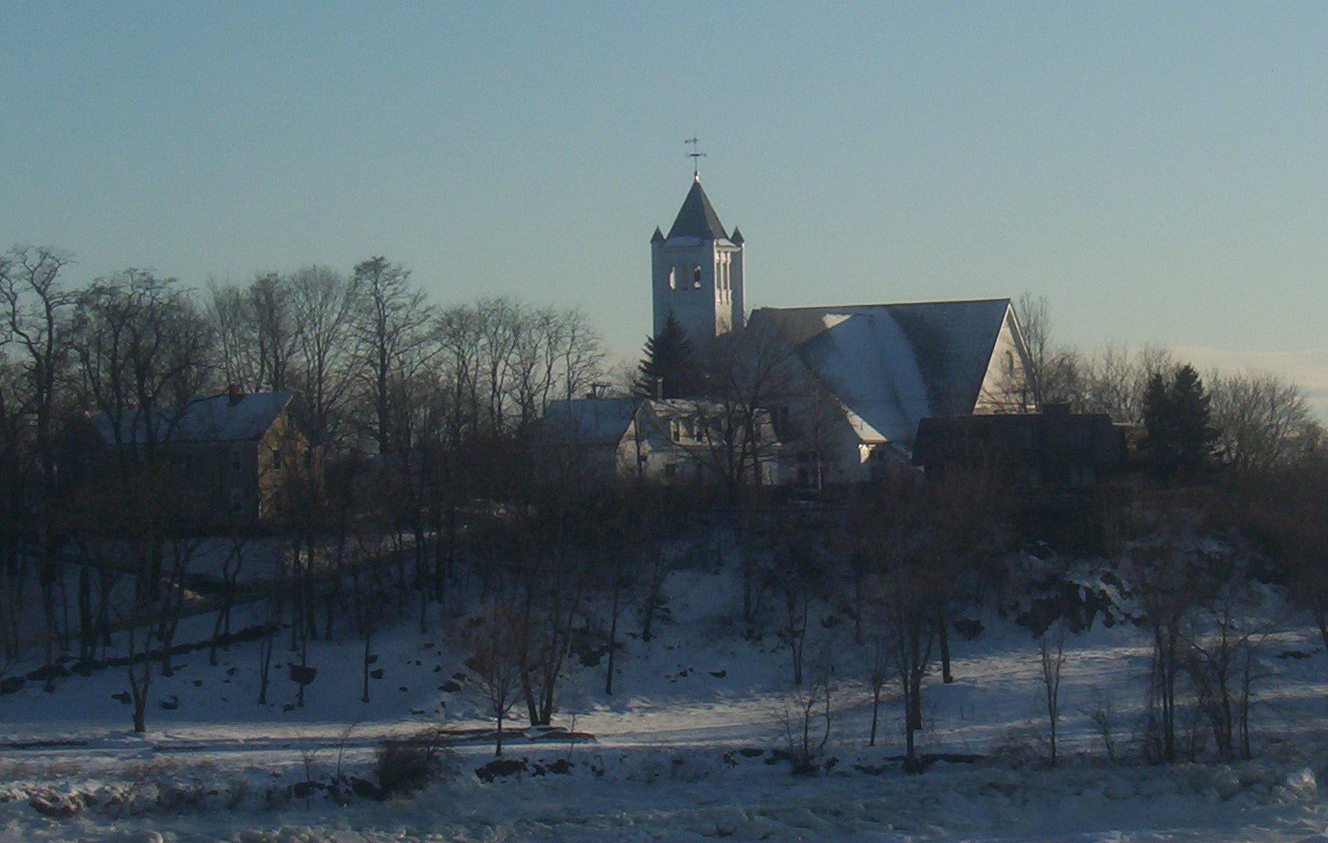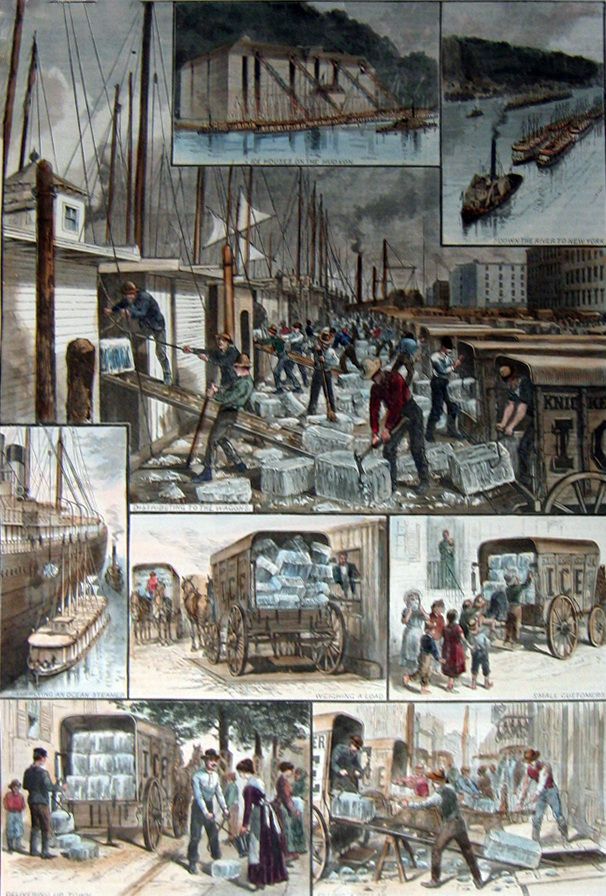|
Brewer, Maine
Brewer is a city in Penobscot County, Maine, United States. It is part of the Bangor metropolitan area. The city is named after its first settler, Colonel John Brewer. The population was 9,672 at the 2020 census. Brewer is the sister city of Bangor. The two are at the head of navigation on opposite sides of the Penobscot River estuary and are connected by three bridges. Brewer and Bangor were originally both part of Condeskeag Plantation, though the Brewer part was also called "New Worcester" after John Brewer's birthplace. In 1788, Orrington, Maine was incorporated with Brewer/New Worcester as its major village. The other half of Kenduskeag incorporated in 1791 as Bangor. Finally, in 1812, Brewer broke away from Orrington and incorporated as a separate town. Geography According to the United States Census Bureau, the city has a total area of , of which is land and is water. The villages of South Brewer and North Brewer are both within city limits. South Brewer ... [...More Info...] [...Related Items...] OR: [Wikipedia] [Google] [Baidu] |
Maine
Maine ( ) is a U.S. state, state in the New England region of the United States, and the northeasternmost state in the Contiguous United States. It borders New Hampshire to the west, the Gulf of Maine to the southeast, and the Provinces and territories of Canada, Canadian provinces of New Brunswick and Quebec to the northeast and northwest, and shares a maritime border with Nova Scotia. Maine is the largest U.S. state, state in New England by total area, nearly larger than the combined area of the remaining five states. Of the List of states and territories of the United States, 50 U.S. states, it is the List of U.S. states and territories by area, 12th-smallest by area, the List of U.S. states and territories by population, 9th-least populous, the List of U.S. states by population density, 13th-least densely populated, and the most rural. Maine's List of capitals in the United States, capital is Augusta, Maine, Augusta, and List of municipalities in Maine, its most populous c ... [...More Info...] [...Related Items...] OR: [Wikipedia] [Google] [Baidu] |
National Register Of Historic Places
The National Register of Historic Places (NRHP) is the Federal government of the United States, United States federal government's official United States National Register of Historic Places listings, list of sites, buildings, structures, Historic districts in the United States, districts, and objects deemed worthy of Historic preservation, preservation for their historical significance or "great artistic value". The enactment of the National Historic Preservation Act (NHPA) in 1966 established the National Register and the process for adding properties to it. Of the more than one and a half million properties on the National Register, 95,000 are listed individually. The remainder are contributing property, contributing resources within historic district (United States), historic districts. For the most of its history, the National Register has been administered by the National Park Service (NPS), an agency within the United States Department of the Interior. Its goals are to ... [...More Info...] [...Related Items...] OR: [Wikipedia] [Google] [Baidu] |
Recto Agricultural Bank 5 Dollars 1849 Urn-3 HBS
''Recto'' is the "right" or "front" side and ''verso'' is the "left" or "back" side when text is written or printed on a leaf of paper () in a bound item such as a codex, book, broadsheet, or pamphlet. In double-sided printing, each leaf has two pages – front and back. In modern books, the physical sheets of paper are stacked and folded in half, producing two leaves and four pages for each sheet. For example, the outer sheet in a 16-page book will have one leaf with pages 1 (recto) and 2 (verso), and another leaf with pages 15 (recto) and 16 (verso). Pages 1 and 16, for example, are printed on the same side of the physical sheet of paper, combining recto and verso sides of different leaves. The number of pages in a book using this binding technique must thus be a multiple of four, and the number of leaves must be a multiple of two, but unused pages are typically left unnumbered and uncounted. A sheet folded in this manner is known as a folio, a word also used for a book o ... [...More Info...] [...Related Items...] OR: [Wikipedia] [Google] [Baidu] |
Getchell Brothers , public high school in Marysville, Washington, USA
{{surname ...
Getchell is a surname. Notable people with the surname include: * E. Duncan Getchell (born 1949), American lawyer * Mike Getchell, retired American soccer midfielder *Robert Getchell (born 1936), American screenwriter *Sumner Getchell (1906–1990), American film actor * William H. Getchell (1829–1910), photographer in 19th-century Boston, Massachusetts See also * Getchell, Washington *Getchell Mine, underground gold mine owned by both Barrick Gold, and Newmont Mining, near Winnemucca, Nevada * Getchell Township, Barnes County, North Dakota *Marysville Getchell High School Marysville Getchell High School is a public high school in Marysville, Washington, United States. It is part of the Marysville School District. The campus has a capacity of 1,600 students and was originally organized into four "small learni ... [...More Info...] [...Related Items...] OR: [Wikipedia] [Google] [Baidu] |
Ice Trade
The ice trade, also known as the frozen water trade, was a 19th-century and early 20th-century industry, centering on the east coast of the United States and Norway, involving the large-scale harvesting, transport and sale of natural ice, and later the making and sale of artificial ice, for domestic consumption and commercial purposes. Ice was cut from the surface of ponds and streams, then stored in ice houses, before being sent on by ship, barge or railroad to its final destination around the world. The trade was started by the New England businessman Frederic Tudor in 1806. Tudor shipped ice to the Caribbean island of Martinique, hoping to sell it to wealthy members of the European elite there, using an ice house he had built specially for the purpose. Over the coming years the trade widened to Cuba and Southern United States, with other merchants joining Tudor in harvesting and shipping ice from New England. During the 1830s and 1840s the ice trade expanded further, with s ... [...More Info...] [...Related Items...] OR: [Wikipedia] [Google] [Baidu] |
Waterfalls
A waterfall is any point in a river or stream where water flows over a vertical drop or a series of steep drops. Waterfalls also occur where meltwater drops over the edge of a tabular iceberg or ice shelf. Waterfalls can be formed in several ways, but the most common method of formation is that a river courses over a top layer of resistant bedrock before falling onto softer rock, which Erosion, erodes faster, leading to an increasingly high fall. Waterfalls have been studied for their impact on species living in and around them. Humans have had a distinct relationship with waterfalls since prehistory, travelling to see them, exploring and naming them. They can present head of navigation, formidable barriers to navigation along rivers. Waterfalls are religious sites in many cultures. Since the 18th century, they have received increased attention as tourist destinations, sources of hydropower, andparticularly since the mid-20th centuryas subjects of research. Definition and te ... [...More Info...] [...Related Items...] OR: [Wikipedia] [Google] [Baidu] |
Steam-powered
A steam engine is a heat engine that performs mechanical work using steam as its working fluid. The steam engine uses the force produced by steam pressure to push a piston back and forth inside a cylinder. This pushing force can be transformed by a connecting rod and crank into rotational force for work. The term "steam engine" is most commonly applied to reciprocating engines as just described, although some authorities have also referred to the steam turbine and devices such as Hero's aeolipile as "steam engines". The essential feature of steam engines is that they are external combustion engines, where the working fluid is separated from the combustion products. The ideal thermodynamic cycle used to analyze this process is called the Rankine cycle. In general usage, the term ''steam engine'' can refer to either complete steam plants (including boilers etc.), such as railway steam locomotives and portable engines, or may refer to the piston or turbine machinery ... [...More Info...] [...Related Items...] OR: [Wikipedia] [Google] [Baidu] |
Saw Mill
A sawmill (saw mill, saw-mill) or lumber mill is a facility where logging, logs are cut into lumber. Modern sawmills use a motorized saw to cut logs lengthwise to make long pieces, and crosswise to length depending on standard or custom sizes (dimensional lumber). The Portable sawmill, "portable" sawmill is simple to operate. The log lies flat on a steel bed, and the motorized saw cuts the log horizontally along the length of the bed, by the operator manually pushing the saw. The most basic kind of sawmill consists of a chainsaw and a customized jig ("Alaskan sawmill"), with similar horizontal operation. Before the invention of the sawmill, boards were made in various manual labour, manual ways, either wood splitting, rived (split) and plane (tool), planed, hewing, hewn, or more often hand sawn by two men with a whipsaw, one above and another in a saw pit below. The earliest known mechanical mill is the Hierapolis sawmill, a Roman water-powered stone mill at Hierapolis, Asia M ... [...More Info...] [...Related Items...] OR: [Wikipedia] [Google] [Baidu] |
Ship-building
Shipbuilding is the construction of ships and other floating vessels. In modern times, it normally takes place in a specialized facility known as a shipyard. Shipbuilders, also called shipwrights, follow a specialized occupation that traces its roots to before recorded history. Until recently, with the development of complex non-maritime technologies, a ship has often represented the most advanced structure that the society building it could produce. Some key industrial advances were developed to support shipbuilding, for instance the sawing of timbers by mechanical saws propelled by windmills in Dutch shipyards during the first half of the 17th century. The design process saw the early adoption of the logarithm (invented in 1615) to generate the curves used to produce the shape of a hull, especially when scaling up these curves accurately in the mould loft. Shipbuilding and ship repairs, both commercial and military, are referred to as naval engineering. The construction ... [...More Info...] [...Related Items...] OR: [Wikipedia] [Google] [Baidu] |
South End, Boston
The South End is a Neighborhoods in Boston, neighborhood in Boston, Massachusetts, United States which is bordered by Back Bay, Chinatown, Boston, Chinatown, and Roxbury, Boston, Roxbury. It is distinguished from other neighborhoods by its Victorian architecture, Victorian-style houses and the parks in and around the area. The South End is the largest intact Victorian row-house district in the country, covering over . It has eleven residential parks. In 1973, the South End was listed on the National Register of Historic Places. Much of the neighborhood was originally marshlands in Boston's South Bay. After it was filled in, construction began on January 7, 1849. It is home to diverse groups, including immigrants, young families and professionals, and it is popular with Boston's gay and lesbian community. The South End has been characterized by diversity since the 1880s, with substantial Irish, Jewish, African-American, Puerto Rican (in the San Juan Street area), Chinese, Itali ... [...More Info...] [...Related Items...] OR: [Wikipedia] [Google] [Baidu] |
Back Bay
Back Bay is an officially recognized Neighborhoods in Boston, neighborhood of Boston, Massachusetts, built on Land reclamation, reclaimed land in the Charles River basin. Construction began in 1859, as the demand for luxury housing exceeded the availability in the city at the time, and the area was fully built by around 1900. It is most famous for its rows of Victorian architecture, Victorian brownstone homes—considered one of the best preserved examples of 19th-century urban design in the United States—as well as numerous architecturally significant individual buildings, and cultural institutions such as the Boston Public Library, and Boston Architectural College. Initially conceived as a residential-only area, commercial buildings were permitted from around 1890, and Back Bay now features many office buildings, including the John Hancock Tower, Boston's tallest skyscraper. It is also considered a fashionable shopping destination (especially Newbury Street, Newbury and Boyls ... [...More Info...] [...Related Items...] OR: [Wikipedia] [Google] [Baidu] |
Brick-making
A brickworks, also known as a brick factory, is a factory for the manufacturing of bricks, from clay or shale. Usually a brickworks is located on a clay bedrock (the most common material from which bricks are made), often with a quarry for clay on site. In earlier times bricks were made at brickfields, which would be returned to agricultural use after the clay layer was exhausted. Equipment Most brickworks have some or all of the following: *A kiln, for firing, or 'burning' the bricks. *Drying yard or shed, for drying bricks before firing. *A building or buildings for manufacturing the bricks. *A quarry for clay. *A pugmill or clay preparation plant (see below). Brick making Bricks were originally made by hand, and that practice continues in developing countries and with a few specialty suppliers. Large industrial brickworks supply clay from a quarry, moving it by conveyor belt or truck/lorry to the main factory, although it may be stockpiled outside before entering the mac ... [...More Info...] [...Related Items...] OR: [Wikipedia] [Google] [Baidu] |










